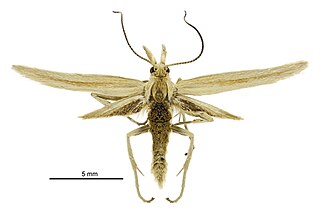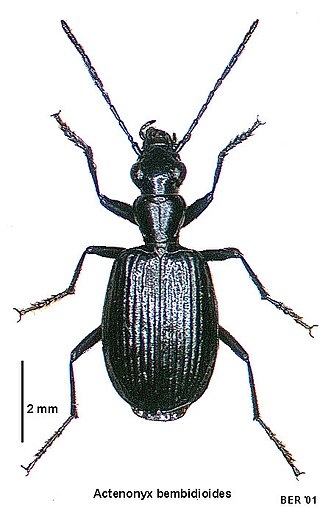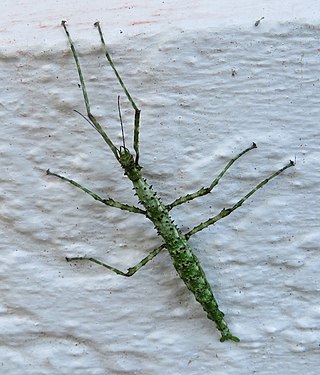Haumia-tiketike is the god of all uncultivated vegetative food in Māori mythology. He is particularly associated with the starchy rhizome of the Pteridium esculentum, which became a major element of the Māori diet in former times. He contrasts with Rongo, the god of kūmara and all cultivated food plants.

Argosarchus is a monotypic genus in the family Phasmatidae containing the single species Argosarchus horridus, or the New Zealand bristly stick insect, a stick insect endemic to New Zealand. The name "horridus" means bristly in Latin, likely referring to its spiny thorax.

Anachloris subochraria is a species of moth of the family Geometridae. It is found in New Zealand and the southern half of Australia including Tasmania and from Queensland across to Western Australia. This moth is day flying and can be found in New Zealand on the wing between November and April.

Exsilirarcha is a genus of moths of the family Crambidae. It contains only one species, Exsilirarcha graminea, which is endemic to New Zealand. Both the genus and the species were described by John Salmon and J. D. Bradley in 1956.

Austrocidaria is a genus of moths in the family Geometridae. It was described by John S. Dugdale in 1971.

Campbellana is a genus of moths of the Carposinidae family, containing only one species, Campbellana attenuata. This species is endemic to the Campbell Islands of New Zealand.

Actenonyx is a genus of beetles in the family Carabidae. At present only species in this genus is Actenonyx bembidioides. However, it has been suggested that a taxonomic revision of this genus is needed as there are two species that await description. This genus and species was first described by Adam White and is endemic to New Zealand.

Clitarchus hookeri, is a stick insect of the family Phasmatidae, endemic to New Zealand. It is possibly New Zealand's most common stick insect. Clitarchus hookeri is often green in appearance, but can also be brown or red. Alongside the prickly stick insect and the Unarmed stick insect, C. hookeri is one of three stick insect species to have become naturalised in Great Britain, with all three having originated in New Zealand.

Clitarchus is a genus of stick insects in the Phasmatidae family and Phasmatinae sub-family. This genus is the most common stick insect in New Zealand. It is found widely throughout the North Island and part of the South Island on kanuka and manuka, as well as various common garden plants.

Acanthoxyla prasina, the prickly stick insect, is a stick insect in the order Phasmatodea and the family Phasmatidae. It is native throughout New Zealand, although it is less frequently reported than "common" stick insect species. It has been introduced to Britain, predominantly Cornwall and Devon, and to the south-west region of the Republic of Ireland. It has a thorny skin, which is used as camouflage.

Acanthoxyla is a genus of stick insects in the family Phasmatidae. All the individuals of the genus are female and reproduce asexually by parthenogenesis. However, a male Acanthoxyla inermis was recently discovered in the UK, probably the result of chromosome loss. The genus is the result of interspecific hybridisation resulting in some triploid lineages and some diploid lineages. The genus is endemic to New Zealand, but some species have been accidentally introduced elsewhere. The genus name Acanthoxyla translates from Greek as prickly stick.

Acanthoxyla inermis is an insect that was described by John Salmon in 1955. Acanthoxyla inermis is included in the genus Acanthoxyla, and family Phasmatidae. No subspecies are listed. This species is native to New Zealand but has been unintentionally moved to Great Britain where it has grown a stable population and is the longest insect observed in the UK, and the most common of the stick insects that have established themselves on the island.

Planotortrix flammea is a species of moth of the family Tortricidae. It is endemic to New Zealand.

Clitarchus rakauwhakanekeneke is a stick insect that belongs the common New Zealand genus Clitarchus. It lives only on the Poor Knights Islands.

Clitarchus tepaki is a stick insect that belongs to the common New Zealand genus Clitarchus. It is endemic to the North Cape area of New Zealand, in particular Te Paki and the Karikari Peninsula.

Proterodesma turbotti is a species of moth in the family Tineidae. It was described by John Salmon & John David Bradley in 1956. This species is endemic to New Zealand, found in the Antipodes Islands and Bounty Islands of the New Zealand Subantarctic Islands.

Notopsalta sericea, also known as the clay bank cicada, is a species of insect that is endemic to New Zealand. This species was first described by Francis Walker in 1850.

Spinotectarchus acornutus is a species of stick insect endemic to New Zealand. It belongs to the family Diapheromeridae, and is the only member of the genus Spinotectarchus. It is commonly referred to as the spiny ridge-backed stick insect.

Niveaphasma annulata is a species of stick insect found in New Zealand.




















